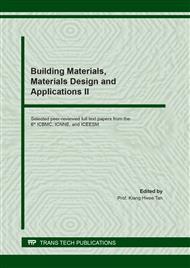p.87
p.99
p.111
p.119
p.129
p.141
p.149
p.157
p.165
Research on Weibull Distribution Theory for Cubic Compressive Strength Test Method of Raw Earth Materials with Different Curing Methods and Time
Abstract:
Cube compressive strength of raw-soil based mater is an important index of mechanical property. Because the test results vary by different curing modes and trial curing time, compressive strength test on 160 cubic raw-soil test-pieces which were made by 4 curing modes (natural curing, indoor curing, indoor+ preservative film curing, curing in standard curing chamber) and 4 Curing period (4d, 14d, 21d, 28d) was designed.In this study,the failure mechanism, failure mode, force mechanism of test were analyzed.Using Weibull distribution theory, the influence of different environmental factors on material strength is discussed.The research revealed that the different curing methods and curing time had remarkable effect on failure mode of material, but the load displacement curves had not affected. The compressive strength with 21d and 28d ‘s indoor curing and standard curing method were same in the test.The strength of raw soil increases with time, and the curing temperature had a significant effect on the early strength of raw soil materials, but had little effect on the later strength. The humidity had a great influence on the later growth of material strength. Constant temperature and humidity could effectively ensure the full response of internal water loss hardening of raw soil-based materials, and the strength of specimens increases obviously.The recommended curing mode and standard curing time for standard test of raw-soil test-pieces were temperature of 25-30oC, humidity of 50%-55%, and 28day, respectively.
Info:
Periodical:
Pages:
129-140
Citation:
Online since:
August 2021
Authors:
Price:
Сopyright:
© 2021 Trans Tech Publications Ltd. All Rights Reserved
Share:
Citation:


